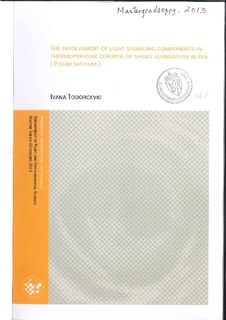| dc.description.abstract | Production of short and compact plants is one of the major challenges in greenhouses. Due to high demand of such plants by the customers, this has been subjected to significant interest in the greenhouse industry, and temperature drops in the morning is commonly used in production of ornamental pot plants and transplants. Stem elongation is controlled by both temperature and light parameters. Earlier studies have demonstrated a differential elongation response to temperature drop in light and darkness, but the knowledge on the mechanism underlying the thermoperiodic control of shoot elongation is still limited. The aim of this study was to investigate the effect of day and night temperature drops as well as the interaction between temperature drop and irradiance on the wild type (WT) pea (Pisum sativum) and pea plants mutated in central photomorphogenesis-related genes, PHYTOCHROME A and B as well as the the HY5 ortolog LONG1 and the COP1 ortolog LIP1 (the long1, lip1, phyA, phyAlong1, phyB and phyBlong1 mutants). It was observed that a temperature drop in the middle of the day resulted in a significant reduction of stem elongation at day 15 in the WT (about 15%) as well as in the lip1 (23%) and phyA (15%) mutants. In phyB there were no differences between day and night drop but stem elongation at day 15 was significantly reduced in both treated groups in comparison to the control. The treatment did not any have significant effect on the other mutants. In the WT and phyA mutant there was no effect of a temperature drop in the night compared to the control. So a day and night drop affect elongation differently in these two genotypes. Our results indicate that PHYA is not important in thermoperiodic control of shoot elongation, while PHYB seems to be needed for the plant to be able to distinguish between a day drop and a night drop. Long1 mutant did not show any effect of a temperature drop, neither in the day or the night, indicating that the presence of the LONG1 gene is essential for a response to a temperature drop. Lip1 mutant, on the other hand, reacted with inhibition of elongation growth both in response to a drop in the day and night, indicating that LIP1 gene, which at least in Arabidopsis is known to be involved in down-regulation of HY5/LONG1 in the dark, must be present for a normal thermoperiodic response in pea.
Our results show that the other measured growth parameters were not significantly affected by temperature drop treatments. Furthermore, the combination of day temperature drop and increased irradiance resulted in a stronger inhibitory effect on shoot elongation in comparison to a temperature drop treatment only. In the WT increased irradiance in combination with a day drop decreased stem elongation significantly by about 45% at day 15, while the reduction in stem elongation was even more pronounced in lip1, phyA and phyB mutants (about 60% at day 15). In plants mutated in LONG1 gene, no effect of increased irradiance alone or in combination with a temperature drop was observed, indicating a central role of this gene in response to increased irradiance as well as a day drop. The other growth parameters measured both in WT and other mutants were also more significantly affected when day drop was applied with increased irradiance suggesting that this combination of treatments might be more stressful to the plants, thus affecting the growth parameters. | no_NO |
